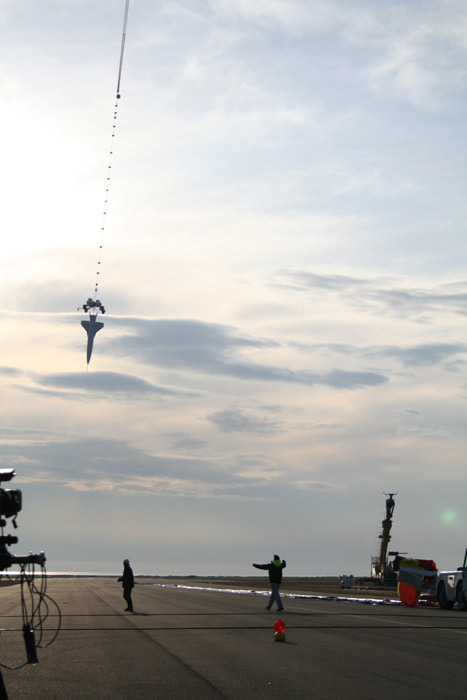Italian Firm Hails Test of Unmanned Spacecraft Prototype

AnItalian aerospace firm is celebrating the first flight of an unmannedspacecraft prototype, though the experimental vehicle was damaged during the13-mile (21-kilometer) drop test.
DubbedCastor, the unmanned space vehicle (USV) prototype reached speeds of up to Mach1.08 as it plunged towards the Mediterranean Sea from a high-altitude balloon, according to the craft's handlers at the Italian Center for AerospaceResearch (CIRA) in Capua, Italy.
Onboardsensors recorded the complete test flight which took place on Feb. 24. [image]
"Thefirst flight was tremendously important for CIRA since it demonstrated theability of CIRA engineers to coordinate and conduct the entire missionoperation," Gennaro Russo, CIRA's Space Programs lead and USV program manager, told SPACE.com.
Castoris a 30-foot (9.2-meter) long Flying Test Bed-1 (FTB-1) with a wingspan of about13 feet (four meters) and some 500 aerodynamic and structural sensors tomeasure stresses of transonic flight [image].The 2,910-pound (1,320-kilogram)vehicle's drop tests are designed to simulate thestresses on a vehicle as it reenters the Earth's atmosphere, CIRA officialssaid.
Duringthe 70-second flight, Castor successfully performed a nose-up maneuver whileflying at transonic speeds between altitudes of about 10 and 6.2 miles (16 to10 kilometers) [image].But after that test phase, the Castor's three-stage parachute descent into theMediterranean Sea occurred at an unexpectedly high speed, severely damaging theexperimental vehicle, Russo added.
"Castorwill have to be rebuilt," Russo said, adding that it would between 12 and 18months to reassemble the experimental space plane.
Get the Space.com Newsletter
Breaking space news, the latest updates on rocket launches, skywatching events and more!
Castor'stwin--named Pollux--is under assembly with plans for a space-bound version, theFlying Test Bed-X (FTB-X), to be launched on suborbital or orbital flights atopa EuropeanVega rocket by 2012, CIRA officials said of the $234 million(179 million Euro) project [image].
Thedata and lessons learned from Castor's first flight, however, could allow CIRAengineers to modify Pollux for a more complex drop test debut-- dubbedDTFT-2--later this year.
"Inparticular, we feel possible that DTFT-2 will reach a maximum Mach of 1.3-1.4,executing a complex nose-up and turn maneuver, followed by an approach flightin order to make the parachute system opening the easiest possible," Russosaid, adding that the plan depends on the ongoing analysis.
- IMAGES: The X-Planes (Part 2, Part 3)
- MULTIMEDIA: The New Space Race
- VIDEO: Virgin Galactic: Let the Journey Begin
- VIDEO: How to Build a Tour-Ship for Space
- Experience the Future of Flight
Join our Space Forums to keep talking space on the latest missions, night sky and more! And if you have a news tip, correction or comment, let us know at: community@space.com.

Tariq is the Editor-in-Chief of Space.com and joined the team in 2001, first as an intern and staff writer, and later as an editor. He covers human spaceflight, exploration and space science, as well as skywatching and entertainment. He became Space.com's Managing Editor in 2009 and Editor-in-Chief in 2019. Before joining Space.com, Tariq was a staff reporter for The Los Angeles Times covering education and city beats in La Habra, Fullerton and Huntington Beach. In October 2022, Tariq received the Harry Kolcum Award for excellence in space reporting from the National Space Club Florida Committee. He is also an Eagle Scout (yes, he has the Space Exploration merit badge) and went to Space Camp four times as a kid and a fifth time as an adult. He has journalism degrees from the University of Southern California and New York University. You can find Tariq at Space.com and as the co-host to the This Week In Space podcast with space historian Rod Pyle on the TWiT network. To see his latest project, you can follow Tariq on Twitter @tariqjmalik.









